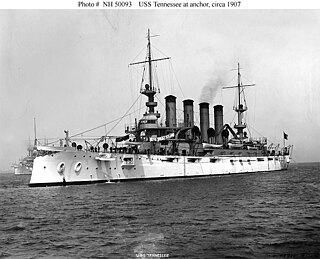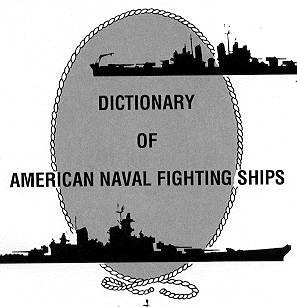
The third USS Charleston (C-22/CA-19) was a United States Navy St. Louis-class protected cruiser. She was launched 23 January 1904 by Newport News Shipbuilding and Dry Dock Co., Newport News, Virginia, sponsored by Miss Helen Whaley Rhett, and commissioned on 17 October 1905, Captain Cameron McRae Winslow in command. She was reclassified CA-19 on 17 July 1920.

The second USS Tennessee (ACR-10), also referred to as "Armored Cruiser No. 10", and later renamed Memphis, was a United States Navy armored cruiser, the lead ship of her class.

USS Taylor (DD-94) was a Wickes-class destroyer built in 1918 for the United States Navy, which saw service in World War I and the years following. She was named for Rear Admiral Henry Taylor.

The first USS Haraden (DD–183) was a Wickes-class destroyer in the United States Navy following World War I. She was later transferred to the Royal Canadian Navy as HMCS Columbia, as a Town-class destroyer.

The first USS Talbot was a torpedo boat in the United States Navy. The ship was named in honor of US Navy lieutenant John Gunnell Talbot.

The first USS Gwin, was launched 15 November 1897 by the Herreshoff Manufacturing Co., Bristol, Rhode Island, and commissioned at Newport 4 April 1898, Lt, (j.g.) C. S. Williams in command.

The first USS Blakely was laid down on 12 January 1899 at South Boston, Massachusetts, by George Lawley & Son and launched on 22 November 1900. Sponsored by Miss Nellie M. White; and commissioned on 27 December 1904, with Lieutenant Charles E. Courtney in command.It was named for Johnston Blakeley commander of the USS Wasp.

USS George F. Elliott (AP-13) was a Heywood-class transport acquired by the U.S. Navy during World War I and then reacquired by the Navy for service as a troop carrier during World War II. In 1942, she was attacked off Guadalcanal by Japanese planes and sank shortly thereafter.

USS Shrike (AMS/MSC-201) was an Bluebird-class minesweeper acquired by the US Navy for clearing coastal minefields.
USS Wave has been the name of more than one United States Navy ship, and may refer to:

USS Searcher (YAGR-4/AGR-4) was a Guardian-class radar picket ship acquired by the U.S. Navy in 1954. She was obtained from the National Defense Reserve Fleet and reconfigured as a radar picket ship and assigned to radar picket duty in the North Atlantic Ocean as part of the Distant Early Warning Line.
USS Yacal (YFB-688) was a small ferry that served in the United States Navy from 1932 to 1942. She was named after the yacal tree, which has hard wood, which was also the primary construction material used to build her.

The second USS Wando, later YT-17, later YT-123, later YTB-123, was a United States Navy tug in commission from 1917 to 1946.
Lillian Anne (YFB-41) was a United States Navy ferry in commission from 1942 to 1943.
The fourth USS Despatch, originally USS Steam Cutter No. 423, later USS Hustle (YFB-6), was a ferry launch that served in the United States Navy from 1902 to 1921.

USS Dart (YFB-308) was a United States Navy ferry launch in service from 1900 to 1930, when she was transferred to the United States Lighthouse Service, and renamed the Locust, she was later transferred to the United States Coast Guard, until she was decommissioned in 1954.

SS West Loquassuck was a steel–hulled cargo ship built for the United States Shipping Board's Emergency Fleet Corporation in World War I. After completion on 15 October 1918, the ship was immediately commissioned into the U.S. Navy as USS West Loquassuck (ID-3638), just weeks before the end of the war.

Admiral Glass was a wooden-hulled ferryboat which was named for Admiral Henry Glass. It was constructed by the Mare Island Navy Yard and launched on 26 July 1916. Accepted and simultaneously placed in service on 22 August 1916, she spent almost a decade operating in the 12th Naval District. Records indicate that for a brief period in 1918 and 1919, Admiral Glass served at the Naval Training Station, Yerba Buena Island. On 17 July 1920, she was classified as a yard craft, YFB-2.

The first USS Moosehead (ID-2047), later the fourth USS Porpoise (YFB-2047), was a steamer that served in the United States Navy from 1918 to 1930.

The first USS Patchogue (ID-1227), later YFB-1227, was a United States Navy ferry in service from 1917 to 1922.
























